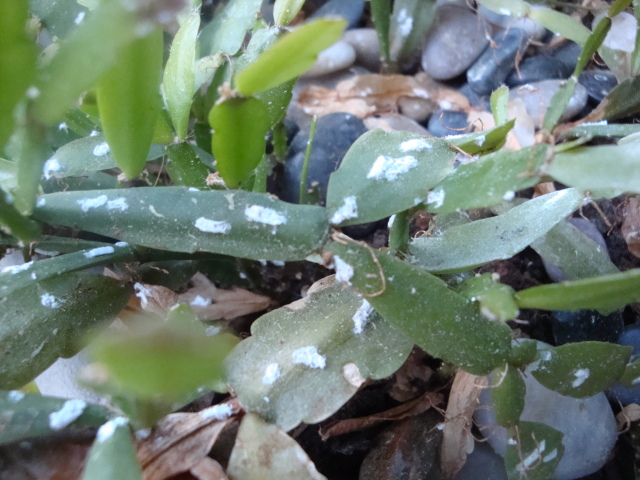QuestionQUESTION: I have a Christmas Cactus that belonged to my grandmother who died 21 years ago. Some time ago it developed a white milky substance on the leaves. I originally thought it was bugs but realized it was seeping this substance. Should i try to clean the leaves? Is this normal?
ANSWER: Dear Diane,
This kind of cactus doesn't normally seep a white milky substance, tho they can secrete some sap that is sticky and clear. it's the white component that worries me. In this case I suspect it is bugs that are releasing or the substance or at least living on the substance. Mealies, mites, aphids( a less likely cause) are soooo tiny. First I'd cut off a few clean branches so you can start a new plant. If there are not clean branches, at least find the ones that are least affected, wipe them down with alcohol and put them aside to pot up. If the affected leaves aren't extensive than gently clean with warm, soapy water or alcohol. If the damage is extensive, spray with systemic insecticide. You may have to do each of these a few times. If it's not remedied by that I'd cut off the affected leaves. In any case, repot in African violet type soil with some extra perlite, first cutting off any roots that are dead and place in a pot that no doubt will be smaller, with a good drainage hole. Let it rest in the new soil for a few days and gradually start watering. This type of cactus is terrestrial and likes to be slightly moist or at least not bone dry. Keep in a semi shaded spot with good circulation. By all means start the leaves you cut off after the tips callous. That way you can insure that you will still have your grandmother's plant.
With any cactus, repot every one to two years so it gets refreshed soil with nutrients and you can check the roots to make sure they're healthy. You only need a pot that has an inch or so around the plant.
I hope you can save your grandmother's plant. I know it's heartbreaking.
If you can, I'd really like to see a close up of the white substance and the whole plant. If you'd rather not do anything too drastic before I see the picture, still snip foo some leaves, and clean the plant as described.
Hope this helps and hope you can send a picture,
Maureen
---------- FOLLOW-UP ----------
 Christmas Cactus
Christmas Cactus
QUESTION: Thank you so much for the information. I have attached a picture of the plant. Please let me know if this changes your response.
Answer
Definitely mealy bugs. Rats.
Mealybugs are the most tenacious of cacti pests. Not only are they a plague to nearly every grower, but they also affect different parts of the plant. There are mealybugs that affect the plant tissue and like to hid out in between ribs and tubercles, there are root mealybugs that live under the soil sucking on the roots, and there are even mealybugs that live on the spines of a cactus and suck the plant juices through the spines.
They are the most common of cacti-eating critters and also quite difficult to get rid of and as I said almost impossible so without the use of a systemic pesticide. Contact insecticides will kill mealybugs, but do have to be added in fairly high concentration due to the protective covering that the insect makes for itself. Also, contact insecticides are risky due to their oily makeup. This can cause the plant epidermis to burn in the sunlight. This is called phototoxicity.
For best results, after physically removing the mealybugs with a toothbrush,alcohol or high pressure water spray, it is best to treat the plant with a systemic insecticide. I use imidacloprid (Isotex), but really what ever is available you is fine. This should be applied only when the plant is growing or it will not be taken into the plant tissues. It is also not a bad idea to treat your cactus at the onset of the growing season to prevent mealybugs from getting a start. Luckily this is they're growing season. Repeat the insecticide 3 weeks later as the bugs lays eggs
Since mealybugs affect different areas of the plant, unlike scale and other critters,check the entire plant when mealybugs are detected. In other words, if you have spine mealybugs, be sure to check down in the joints of the plant and unpot the plant and inspect the roots.
You are likely to see them there so try to get as much of the soil off as possible. Repot. When I start to water again in a few days, I water with half alcohol and half water, but not every one does this.
It's always a good ides to spray any plant at the beginning of the growing season. Breezes bring is all kinds of nasty bugs - mealies, spider mites, scale. Yuck.
Remember not to put your plant in full sun, but rather after a period of semi shade, gradually move to bright light to prevent burning.
Don't be discouraged. You have a big task ahead. Oh, hen you do spray, make sure you're in a well vented area, and you probably wear a mask.
Good luck,
Maureen






